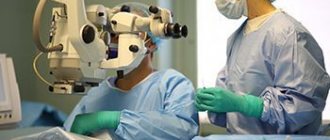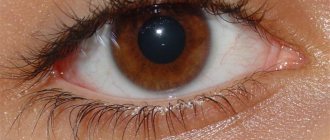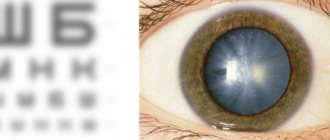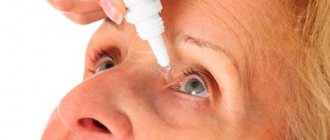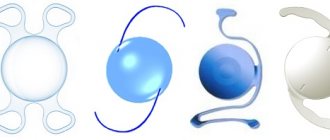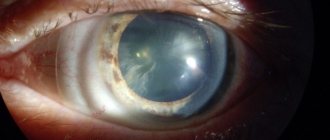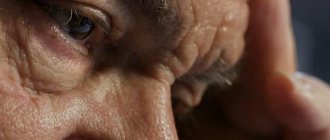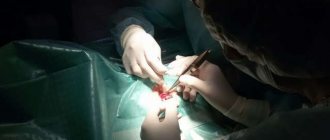Many diseases can be prevented with a healthy lifestyle and proper nutrition. Cataracts are no exception. Many ophthalmologists are confident that following a certain diet throughout life will delay the onset of this disease, or even prevent it altogether.
Nutrition for eye cataracts allows you to reduce the impact of unfavorable factors on the visual organs and compensate, for example, for the effects of high blood sugar, blood pressure, and bad habits. Diet itself is not able to stop the process of clouding that has already begun - there is no point in revising your diet if you have diagnosed cataracts, thereby hoping to get rid of the disease. But proper nutrition serves as an excellent preventive method and helps with conservative treatment.
Diet of patients with cataracts
Since this disease appears mainly in old age and is considered a consequence of the aging of the body, doctors recommend consuming foods that slow down this process. In this regard, you will have to give up the abundance of meat in your menu, which increases sclerotic diseases and leads to an excess of cholesterol in the blood. It is desirable that a person’s diet contains more vegetarian products: fresh vegetables and fruits, herbs. They slow down the aging process and have a beneficial effect on the cardiovascular system.
Particular attention is paid to products rich in vitamins C and E - they inhibit the development of cataracts and prevent its occurrence. Therefore, foods containing these components should predominate in the diet:
- Nuts, seeds and plant seeds.
- Greens: spinach, turnips, kale, parsley.
- Vegetable oils - sunflower, hemp, cottonseed, coconut, olive, etc.
- Berries of rosehip, juniper, sea buckthorn, black currant.
- Pepper, kiwi.
Nutrition for eye cataracts must include various antioxidants, which are mainly found in vegetables and fruits. Simply put, heavy meat eaters are much more likely to develop cataracts than vegetarians. Attention should also be paid to standard “vision improvers”, which help strengthen the eyes and serve as an excellent preventive measure for many diseases. These include vitamin A-rich carrots, vitamin E-rich soy, sulfur-rich garlic, omega-3-rich sardines and salmon, and lutein and zeaxanthin from broccoli, which helps keep your eye lenses healthy.
Nutrition for eye cataracts: healthy foods and diet
What should you eat if you have cataracts? Nutrition for cataracts involves avoiding certain foods. As much as possible, you should include “correct” dishes in your diet. Food should be healthy. If you have cataracts, you should avoid eating fatty foods. They not only provoke the development of the disease, but also become the cause of relapse after long-term drug treatment.
It should be understood that a disease such as cataracts is an ever-worsening disease. The only true treatment is surgery.
Neutralize free radicals
Cataracts of the eye are insidious in that they can appear at any age. In older people, the disease is provoked by the aging processes of eye tissue, in young people - by eye injuries and heredity.
Free radicals are molecules that are particularly active.
Action of free radicals:
- They “take” electrons from other molecules, which, in turn, immediately become harmful molecules. This process can take forever.
- The more harmful molecules there are, the faster the process of severe oxidation occurs in the body.
The body needs free radicals, but in very small quantities. They help the immune system destroy harmful infections. But as soon as their number increases, various pathologies immediately begin to develop in the body. And eye cataracts are not the only disease caused by harmful molecules. The consequences of a large number of harmful molecules are cancer, stroke, heart attack, premature aging of the body.
Free radicals enter the body in most cases with harmful foods. But there are other ways to penetrate them into the blood.
Interesting! In 10 minutes, while a person fills up a vehicle at a gas station, he receives a dose of gasoline fumes that contains an amount of free radicals that his ancestors did not receive in their entire lives.
A diet for clouding the lens of the eye involves excluding foods that contain harmful molecules. There are useful products that can help get rid of them. Antioxidants neutralize the effects of harmful molecules, sweeping them out of the body like a broom.
Antioxidants are also called antioxidants. Contained in many foods.
- Block harmful molecules.
- These molecules coagulate and remove them from the body, preventing the development of pathologies, including cataracts.
Vitamins to help
As soon as there are fewer useful elements, the process of cataract development immediately begins. It is clear that food should contain the maximum amount of antioxidants.
Daily intake of antioxidants for cataracts:
- Vitamin C. Men - up to 100 mg, women - up to 80 mg, smoking women and men - up to 40 mg.
- Vitamin E. Regardless of gender, people should consume up to 20 mg of natural vitamin every day, up to 23 mg of synthesized vitamin.
- Lutein, zeaxanthin – up to 7 mg.
Vitamin C is found in:
- lemon;
- orange and freshly squeezed orange juice (store-bought juices may also contain free radicals, so the diet requires the use of freshly prepared drinks);
- grapefruit and freshly squeezed grapefruit juice;
- melon and melon seeds;
- strawberries;
- green sweet pepper;
- broccoli;
- tomato juice;
- fresh and dry rose hips;
- black currant;
- kiwi;
- honey and propolis;
- greenery;
- gooseberries;
- Brussels sprouts;
- green peas;
- Quince;
- radish.
Vitamin E (folic acid) is found in:
- sunflower and butter;
- sunflower seeds;
- almonds, walnuts, peanuts;
- broccoli;
- sea buckthorn;
- apple and pear seeds.
Lutein and zeaxanthin are found in:
- spinach;
- broccoli;
- mustard and dandelion leaves;
- turnip tops;
- green peas;
- citrus fruits;
- peaches;
- apricots;
- melon;
- pumpkin;
- corn;
- apples;
- pomegranates;
- red grapes;
- tomatoes;
- beets
As you can see, the diet should contain foods for cataracts such as vegetables and fruits. But meat products are also not prohibited.
- You can eat chicken, rabbit, beef.
- Seafood and fish are rich in zinc, which also prevents the development of cataracts. When it comes to fish, it is better to give preference to marine species.
When the lens of the eye becomes cloudy, food should be steamed or baked in the oven. It is necessary to remember that many fruits and vegetables, during heat treatment, lose some of their beneficial elements. Therefore, it is better to give preference, for example, to fresh strawberries rather than compotes made from them.
It is better to eat food fractionally, that is, in small portions, but often. To ensure that the diet does not harm a person, you should consult a nutritionist. Because many foods can cause allergies.
What drinks will help destroy free radicals that damage the eyes:
- green and herbal tea (thyme, chamomile, oregano, St. John's wort, strawberry - these plants are the strongest antioxidants in nature, which means they can suppress the action of free radicals);
- mineral still water;
- freshly squeezed juices - you can drink them in unlimited quantities (the juice of pumpkin, carrots, beets, cucumber, spinach, parsley is especially useful).
Juices should be prepared and drunk immediately. After the drink sits for 2-3 hours, it already loses half of its beneficial properties.
Beta-carotenes for cataracts
Beta-carotene is also an antioxidant. The lack of this substance leads not only to cataracts, but also to night blindness; perforation of the cornea of the eye; chronic inflammatory process of the edges of the eyelids (blepharitis); the process of drying of the corneal conjunctiva (xerophthalmia); damage to the cornea, which causes tissue melting and necrosis (keratomalacia); complete loss of vision.
One molecule of beta-carotene can destroy a thousand molecules of free radicals. In addition, this substance can eliminate the damage caused by free radicals.
The highest beta-carotene content is found in:
- boiled carrots (boiled carrots contain more carotene than raw ones);
- greenery;
- apricots;
- turnip;
- cabbage;
- red bell pepper;
- egg yolks;
- butter;
- parsley;
- sour cream;
- liver;
- watermelons;
- sweet potatoes.
It’s not for nothing that mothers, especially girls, say in childhood that they need to eat carrots and parsley to make their eyes beautiful. Such food will help prevent the development of various ophthalmic pathologies, including cataracts. All of the above products must be included in the diet, especially by people who are at risk.
Foods that trigger the development of cataracts
- The No. 1 food that causes cataracts is sugar. The lens is a gel-like transparent substance. When the level of glucose in the blood increases, this element of the eye is able to “sugarify”. If a person’s diet includes a lot of sweet dishes, and he likes to indulge in sweet tea and cakes, then glucose will concentrate in the lens, causing it to become cloudy. Older people especially need to monitor their sugar intake. You also need to exclude confectionery and chocolates.
- In second place are fried and fatty foods. This food contains a huge amount of free radicals and cholesterol. Moreover, even healthy foods, such as eggs, can contain harmful elements. If a person, after frying eggs or a piece of lard in a frying pan, sees a black crust, then he should know that by eating such a dish he will saturate his body with free radicals. By the way, experts believe that lard is a harmful product. But as the truth goes, everything is useful in moderation. If you have cataracts, you are allowed to eat no more than 50 g of lard per day. In this case, harmful cholesterol will not be produced. In this amount, lard is even useful.
- Alcoholic drinks occupy third place. Not only does ethanol kill all vitamins and nutrients in the body, but when consumed in excess, it promotes the formation of free radicals. People suffering from cataracts or those who have undergone lens replacement surgery should avoid drinking alcohol as much as possible. The monthly dose is no more than 150 ml (meaning dry white wine).
For early cataracts, diet will help prevent vision deterioration. But ultimately the disease will still progress. Therefore, it is better not to hesitate and have surgery right away.
YOU MAY BE INTERESTED in: Indications for cataract surgery Vision has not been restored after cataract removal Are cataracts dangerous?
Causes of cataracts
To understand why a proper diet is so important for cataracts, you need to know about the causes of the development of this disease.
Many patients diagnosed with early cataracts have a deficiency of zinc, copper, riboflavin, vitamins B, E and C. Taking vitamin complexes and eating foods rich in essential substances with antioxidant properties are important components in the prevention and treatment of cataracts. Why does the lens of the eye become cloudy? Clouding processes are associated with changes in the chemical composition of the lens, a decrease in the activity of a number of enzymes with a significant decrease in water-soluble proteins. The accumulation of toxic compounds becomes possible due to the action of free radicals against the background of a decrease in natural antioxidants. This leads to changes in protein molecules and clouding of the lens. You can slow down the growth of cataracts by taking vitamins that improve metabolism and increase the antioxidant protection of cells.
A person suffering from cataracts can get some useful vitamins from food: freshly prepared juices, herbal teas, the components of which help strengthen blood vessels and improve tissue blood flow.
List of means used for prevention purposes
Above, we briefly reviewed eye drops for cataracts, namely for its treatment. But it is no secret that the best cure for a disease is prevention (after all, it is always easier to prevent the onset of a disease than to treat a disease).
It is used to relieve tension in the eyeballs, and also as a preventive drug against eye diseases caused by infection. This remedy has a positive effect on the metabolic processes of the lens, which can prevent age-related visual changes, including the development of cataracts.
The components of reticulin are: terminalia cambula extract, basil officinalis extract, adenosine, cytochrome.
Contraindications to the use of the substance include individual intolerance to the components of the drug, and an adverse reaction may be an allergy.
Vitamins are one of the methods for preventing and treating early cataracts. These products can be registered as dietary supplements (dietary supplements) or medications; they are produced, most often in the form of tablets or pills, but syrups and other forms (pastes, solutions) can be found.
According to statistics, cataracts affect every fifth person on the planet over 55 years of age. With age, if preventive measures are not taken, the likelihood of developing cataracts increases rapidly. However, proper nutrition can reduce this risk by almost 100%.
Cataract is an age-related disease, and this fact is generally accepted; it is caused by exposure to free radicals, which can be reduced by additional intake of vitamins E and C, beta-carotene, as well as elements such as chromium and selenium.
It has long been noted that people suffering from cataracts have low levels of vitamin C. At the same time, they have a lack of zinc, copper, manganese and glutathione, which is normally produced by the body itself, provided there is sufficient selenium. Occasionally, in addition, a lack of vitamin B3 and riboflavin is noted.
The presence of mercury and other toxins in the body plays an important role in the development of the disease. Laboratory studies of the blood of patients with cataracts revealed that zinc deficiency is experienced by 60% of patients, copper deficiency by 15%, manganese deficiency by 90%, and almost all patients experience an acute lack of selenium.
Moreover, the deficiency of these elements significantly reduces the effect of vitamins C, E, as well as beta-carotene in the body.
What can't you eat?
When taking care of healthy vision, you should also exclude or significantly limit some foods in your diet that are detrimental to eye health. These include:
- coffee: impairs the supply of nutrients to the eyes;
- alcohol: reduces the absorption of riboflavin, which is necessary for vision;
- salt: its excess significantly increases the likelihood of cataracts;
- carbohydrate-rich foods (buns, cakes, pasta) - affect the health of the macula and cornea.
Symptoms of cataracts
If it becomes more difficult to look into the distance, as well as to distinguish objects near, this is a reason to make an appointment with an ophthalmologist. Unfortunately, when cataracts appear, signals are often not noticed, so doctors come to the clinic when the condition is already advanced. It is widely believed that the main symptom is a decrease in visual acuity, but this only happens when changes affect the center of the lens. If they begin in other areas, then this has no or almost no effect on the visual perception of the surrounding world.
There are different degrees of damage, each of which has its own symptoms. But we can name something common to all:
- Double vision in one eye when the other is closed. It appears only at first and then disappears.
- Feeling of blurred or blurred vision. An unclear picture cannot be corrected with glasses and contact lenses. Visibility is poor both far and near.
- Sudden visual flashes of light that usually occur at dusk and darkness. They are called night flares.
- Deterioration of night vision and increased sensitivity of the eyes to light. Any lighting sources cause discomfort: they seem overly bright and irritating.
- Halos around light sources that are not visible to people with normal vision.
- Inability to subtly distinguish shades. This applies to any color, but the nuances of purple and light blue are particularly challenging.
- Temporary improvement in vision. Sometimes even people who constantly use glasses can go without them for some time. Also, at a close distance everything is seen better, but at a distance there is a sharp deterioration. This occurs due to clouding of the central area.
- Rapid decrease in visual acuity. Can be assessed by the frequency of changing glasses or contact lenses.
- The feeling that the world around you is behind foggy glass, as stripes, balls, and shapeless spots are in the way. In ancient Greece, cataracts were called “Waterfalls” because of the feeling that excess moisture around them interferes with vision.
- It is difficult to drive due to glare from oncoming headlights and discomfort from street lights.
- It becomes difficult to read, write, sew, and pick up small parts because the outlines seem blurred.
- In later stages, the natural black color of the pupil becomes white.
Symptoms
The name of the disease was given by the ancient Greeks. The word kataraktes means "waterfall".
With cataracts, a person sees “as if in a fog,” as if through foggy glass or through “falling water.” As cataracts develop, the “fogginess” of vision increases, a person feels more and more acutely a veil before the eyes, flickering stripes, spots and streaks. Photophobia appears, images often appear in two, and difficulties arise when reading, writing, sewing, and working with small parts. At the overripe stage of cataract, the color of the pupil becomes white.
Age-related cataracts are a progressive disease that undergoes several stages of development:
- Initial cataract (clouding of the lens occurs on the periphery, that is, outside the optical zone). The patient usually does not make any complaints; the presence of the disease can be determined by an ophthalmologist during an examination. Doctors often discover symptoms of early cataracts by chance during a medical examination.
- Immature cataract (opacity moves into the central optical zone). Visual acuity is noticeably reduced. The patient complains of thick fog before the eyes. The disease leads to difficulties in self-care and performing professional duties. The patient requires surgical treatment.
- Mature cataract (opacities occupy the entire area of the lens). There is a decrease in vision to the level of light perception. The patient sees only the outlines of objects located at arm's length.
- Overripe cataract (the substance of the lens liquefies and it acquires a uniform milky-white hue). The patient can detect the presence of a bright window in the room or the light from a flashlight aimed at the eye. Overripe cataracts can cause numerous complications. The development of secondary glaucoma is especially dangerous due to compression of the surrounding tissues of the eye by an enlarged, clouded lens. The ligaments that hold the lens are also involved in the dystrophic process (an example is macular degeneration of the retina). They can rupture, causing the lens to dislocate into the vitreous. The proteins of an overripe lens are perceived by the tissues of the eye as foreign, and this can cause the development of iridocyclitis.
Read more about vision testing and glasses selection here.
Signs
For people with cataracts after the age of sixty, a number of characteristic features are discovered: opacities in different places of the eye - opposite the pupil or on the periphery of the lens. The grayish colors of the altered zones may have white tints.
The clinical picture depends on the location of the lesion and other factors:
- Anterior - upon examination, a white spot with clear boundaries is visible. If there is a slight protrusion and sharpening, a diagnosis is made of anterior pyramidal cataract.
- Posterior polar - a modified area in the shape of a white ball. Located at the posterior pole of the lens.
- Central - a spherical area of turbidity in the center. Its diameter is 2 mm.
- Fusiform - looks like a thin spindle, which is why it got its name.
- Zonular congenital - a cloudy formation with transparent layers.
- Dense soft - the entire lens is clouded, in the first stages it liquefies and then thickens.
- Diabetic - white flakes are found on the surface of the lens, which occupy its entire surface. The iris may change.
- Tetanic – similar in manifestations to diabetic. Occurs due to hypofunction of the parathyroid glands.
- Toxic - lesions are located under the lens, and subsequently move to the cortical layers.
- Senile – it is characterized by many signs that depend on the stage of the disease.
Identifying the signs helps to accurately characterize the disease to classify it into a specific type.
Causes of cataracts
To date, several causes have been identified that lead to the development of the disease:
- diabetes mellitus and other thyroid pathologies, including titania, muscular dystrophy;
- smoking;
- prolonged alcohol abuse;
- eye injuries;
- taking corticosteroids;
- long and frequent exposure to bright sun without high-quality protective glasses (cheap sunglasses can also cause serious harm);
- the body's inability to cope with toxins from the external environment and a decrease in natural levels of antioxidants that develop with age;
- disruption of lens metabolism due to retinal detachment and other problems, including iridocyclitis, chorioretinitis, Fuchs syndrome, glaucoma;
- a number of serious infections, for example: malaria and smallpox;
- anemia;
- exposure to toxic substances;
- skin diseases, including eczema and neurodermatitis;
- eye burns;
- severe myopia;
- hereditary predisposition;
- trisomy on chromosome 21 (Down syndrome);
- severe infections suffered by the mother while carrying a child: influenza, rubella, toxoplasmosis;
- production factor due to working in conditions where you can receive radiation, including ultraviolet rays.
Unfavorable environmental conditions are also cited as reasons.
According to a number of official sources, cataracts that arise for the reasons described above serve as an impetus for the onset of blindness.
Reasons for appearance
Normally, the lens is completely transparent. It consists of water, proteins and minerals. The lens is nourished by intraocular moisture, which, produced in the eye, constantly washes it. But with age, metabolic products begin to accumulate in this fluid, which have a toxic effect on the lens. This entails disturbances in its nutrition, as a result of which the lens loses its former transparency. The nature of the opacities varies, so the typical variety of cataracts is quite extensive.
In addition to age, the formation of lens opacities is also influenced by some eye diseases, as well as pathologies of other organs. These types of cataracts are called complicated. They develop with glaucoma, myopia, diseases of the choroid, retinal detachments and pigmentary dystrophies.
Types of cataracts
According to etiology, cataracts are divided into:
- congenital (sequential);
- age (senile, senile);
- complicated cataracts resulting from an ophthalmopathological process (uveitis, glaucoma, etc.);
- complicated cataracts caused by general diseases of the body (diabetes mellitus, hypothyroidism, etc.);
- secondary (appears after extracapsular extraction);
- traumatic;
- radial;
- toxic.
Depending on the location of the opacities, age-related cataracts are:
- anterior polar;
- posterior polar;
- fusiform;
- layered;
- nuclear;
- cortical;
- posterior subcapsular (cup-shaped);
- total.
Age-related cataracts have a progressive course. Depending on the degree of maturity, there are 4 forms: initial, immature, mature and overripe.
First, clouding is observed outside the optical zone.
When immature, the process spreads in the center of the optical region, reducing the acuity of visual perception, which cannot be ignored.
When it is mature, the lens becomes completely cloudy, so the person only has difficulty distinguishing light.
When overripe, the pupil turns from normal black to milky white. This happens because its tissues liquefy.
In 0.03-0.06%, the course of age-related cataracts can be complicated by rupture of the lens capsule and the development of acute phacolytic iridocyclitis, secondary phacogenic glaucoma Source: Ilyina S.N. Surgical treatment of age-related cataracts at the present stage / S.N. Ilyina, P.Ch. Zavadsky // Journal of GrSMU. - 2009. - No. 1. - P. 84-91. .
Traditional recipes for eye drops for the prevention of cataracts
Cataract is an eye disease, the main manifestation of which is clouding of the lens. With pronounced clouding, the pupil area takes on a grayish or almost white color, and vision is lost. The reasons for the development of cataracts are varied.
Ultraviolet and infrared radiation, radiation, also contribute to the rapid development of the disease. More often it happens in old age. By this time, areas of grayish-white opacities are formed in the tissues of the lens, which, merging, lead to general opacification.
In the lens, an imbalance occurs between water and the ratio of soluble and insoluble protein compounds, and metabolism at the cellular level is disrupted. According to the degree of maturation, there are immature (initial), mature and overripe cataracts.
Treatment is most often surgical, and if the patient’s retina and optic nerve are not damaged, after surgery to replace the lens, vision may become normal. For the treatment of cataracts, traditional medicine offers its own methods and medicinal plants.
Here are some common recipes.
Honey for cataracts is useful not only as a food product.
- No less useful are honey drops prepared with distilled or spring water. They relieve pain in the eyes. prevent the progression of cataracts and excessive drying of the mucous membranes, serve as a prevention of inflammatory eye diseases and nourish all eye structures with useful substances. To prepare honey drops, you need to mix linden honey with distilled water in a 1:1 ratio. Instill several times a day daily, putting 2-3 drops into each eye. The course of treatment must be at least 2 months. This is a time-tested recipe that our grandmothers and great-grandmothers used.
- Eye drops from geranium juice are prepared in the same way. which needs to be instilled twice a day, a few drops in each eye. The course of treatment with geranium juice is long, positive results can be seen only after 3-4 months of regular instillation. Naturally, such treatment must be combined with proper nutrition and mandatory eye protection with sunglasses with side panels that provide 99-100% protection from UVA and UVB.
Rate of cataract maturation
Scientific statistics show that on average over six years the disease develops and causes blindness in 12% of patients. Over a period of six to 10 years, 70% become completely blind, over 15 years – 15%. Patients require surgical treatment, but some of them cannot undergo surgery due to age-related complications or other problems. Surgical intervention does not guarantee the restoration of absolute health, which is why it is so important to seek help as early as possible and prevent consequences that radically change living conditions for the worse.
What to do if you find symptoms of cataracts?
The best decision is to immediately visit a specialist to confirm or refute the diagnosis.
Diagnosis of cataracts includes a set of standard and alternative research methods. Standard methods include visometry, keratorefractometry, perimetry, tonometry, biomicroscopy, and ophthalmoscopy. In addition to biomicroscopy, lens transparency can also be measured by microdensitometry of optical sections. A mandatory element of assessing the size of eye structures in the examination protocol for a patient with cataracts is ultrasound biometry in A-mode.
Alternative methods for examining patients with senile cataracts include:
- methods for studying central visual acuity (autoophthalmoscopy, central critical frequency of flicker fusion, lability of the visual analyzer, macular electroretinography, visual evoked cortical potentials, etc.);
- methods for studying peripheral vision (measurement of the threshold of electrical sensitivity of the retina, electroretinography, etc.).
Taking into account the irreversible consequences leading to disability, depriving the most important of the senses, it is necessary to check with an ophthalmologist at the slightest suspicion. Experts recommend carrying out preventive examinations regularly, especially when working in unfavorable conditions, eye injuries, or serious infectious diseases. The older a person is, the more often he needs to see a doctor, since he belongs to a risk group.
What to do if you are diagnosed with cataracts?
Delaying the start of treatment is dangerous. Even if it seems that everything remains normal. The insidious disease progresses unnoticed, causing irreparable harm. First, the quality of life decreases, and then pathologies arise one after another: intracranial pressure increases and glaucoma develops. The optic nerve dies, causing nerve impulses to stop flowing to the brain and blindness occurs.
After making a diagnosis, the ophthalmologist prescribes therapy, which must be started immediately.
Methods for treating cataracts
The first and one of the most important conditions for combating the disease is an early visit to an ophthalmologist. Treatment can be conservative or surgical.
First, measures are taken to slow down pathological processes. Medicines that stimulate metabolic processes are prescribed. Speeding up metabolism slows down cloudiness. But we must remember that interrupting the use of funds negates all efforts.
Progression of cataracts to a condition requiring surgical treatment occurs in 70% of cases within 6-10 years Source: Ilyina S.N. Surgical treatment of age-related cataracts at the present stage / S.N. Ilyina, P.Ch. Zavadsky // Journal of GrSMU. - 2009. - No. 1. - P. 84-91. . The high level of modern medicine allows surgery to be performed without hospitalization. All manipulations are performed on an outpatient basis, after which the patient remains briefly under the supervision of the clinic’s medical staff, and then can go home. This scheme allows you to avoid discomfort and recover in a familiar home environment, which has a particularly positive effect in old age.
Cataract classification
There are several types of the disease according to the appearance and location of the clouding:
- Nuclear is the most common type. Includes the central part of the lens.
- Cortical - involves the outer layer of the lens. Often develops in early childhood.
- Capsular - characterized by clouding of the lens capsule surrounding it.
- Posterior subcapsular - accompanied by clouding of the posterior part of the lens.
- Total - the lens is completely cloudy. Often the process is two-way.
- Layered - during diagnosis, cloudy and transparent layers are found that alternate.
There is also a classification according to the level of maturity and progression. Within its framework, the following types are distinguished:
- Immature - lens opacities present but still separated by areas of normal, clear lens.
- Mature - the lens is completely opaque and cloudy.
- Initial - vision decreases, but the central part of the lens, the core, remains intact for a long time. The patient complains of a film before his eyes and small dots in the image.
- Overripe - the lens is completely exposed to the pathological process. The lens disintegrates and blindness occurs.
The risk of developing the disease over a 10-year period in people over 49 years of age is 36% for the nuclear types of the disease, 28% for the cortical type. The frequency of pathology occurring in young people is significantly lower compared to older people.
Surgical methods
The main method of treating cataracts is surgical (extraction of the clouded lens).
Intracapsular extraction was used relatively recently, but in many cases it led to injury to the operated patients. They refused it.
Extracapsular extraction - complete removal of the clouded substance, but preserving its own capsule, which is filled with an intraocular lens - rigid but flexible.
Phacoemulsification - removal of opacities using ultrasound. It is a modern minimally invasive high-tech method of rehabilitation of patients with cataracts, allowing to obtain high visual acuity in 89% of patients Source: Galeev R.S. Operation phacoemulsification in the rehabilitation of patients with cataracts / R.S. Galeev, T.R. Galeev // Proceedings of the International Symposium “Reliability and Quality”. — 2007. . With it, the lens’s own capsule is preserved, but the substance filling it is replaced by an intraocular lens. Completes in about 10 minutes, which is much less than other methods. Unpleasant consequences are minimized due to the fact that general anesthesia is not used. Instead, local anesthesia is sufficient. After the manipulations, the patient is prescribed drops and recommendations are given. He should be seen by an ophthalmologist at his clinic.
Drug treatment of age-related cataracts
Only an experienced ophthalmologist can diagnose and treat eye cataracts. Before starting pathology therapy, a number of diagnostic studies are carried out, with the help of which the stage and characteristics of the course of the disease are determined. If the initial stage of the pathology has been diagnosed, then drug therapy is prescribed, including the following drugs for cataracts:
- means that normalize metabolic processes: Fakovit;
- ascorbic acid;
- vitamin-mineral complexes, dietary supplements;
- eye drops: Taufon, Quinax, Vitafacol and others.
Read in a separate article: Treatment and removal of eye cataracts with laser - features and recommendations
The basis of conservative treatment of cataracts in the elderly is the use of various eye drops. It is not possible to cure cataracts using a conservative method, but medications for cataracts improve nutrition, stabilize IOP and slow down the pathological process.
It is not possible to cure the disease using a conservative method, but medications for cataracts improve nutrition, stabilize IOP and slow down the pathological process.
Therapy after surgery
The operation doesn't end there. It is necessary to prevent possible complications, therefore it is imperative to follow the recommendations of the ophthalmologist: do not lift heavy objects, be exposed to dust, wind, or hypothermia for the entire rehabilitation period.
Medicines are also prescribed depending on the indications. They are prescribed in the form of drops that you can instill yourself.
Eye drops, which are usually prescribed immediately after surgery
- Floxal, Oftavix, Torbex - antibacterial drugs;
- Diclof, Indocollir - to relieve inflammatory processes;
- Oxyal, Systane - tear substitutes that are prescribed for increased dry eyes;
- Maxidex and Oftan-dexamethasone are hormonal drops.
Following the recommendations helps you quickly go through the rehabilitation period and return to normal life. Drops prescribed by a doctor should be used, since only he knows the course of the disease and the characteristics of the patient. Self-medication is unacceptable. Without prior consultation with a doctor, it is extremely dangerous.
Medicines used for treatment and prevention
Oftan katachorm is a medicine that plays the role of an antioxidant. Contains nicotinamide, citrom C, adenosine, which are not absorbed into the bloodstream. Normalizes metabolism, activates reduction and oxidative reactions. The effect is observed within the first minute after instillation.
Side effects described as tingling and burning are brushed aside. In rare cases, dizziness occurs, blood pressure rises, and nausea occurs. But these symptoms appear very rarely. Even less common are shortness of breath and fainting.
While pregnant, drops can only be used after consulting a doctor.
The medicine should not be used by children under 18 years of age.
If you are sensitive to any of the components of the drops, therapy is not prescribed or is stopped immediately if problems are discovered only after the start of treatment.
You should avoid wearing contact lenses while taking this medication.
If your eyes are irritated, you should not drive a car or work with equipment if there is a danger of technology violation.
Quinax is a medicine that helps the resorption of proteins that arise in the lens. They also activate enzymes in the anterior chamber of the eye. The liquid is practically not absorbed, does not interact with other medications, and has no side effects. However, pregnant women and children can instill it only after consultation with an ophthalmologist.
The therapeutic effect is noticeable immediately, but the product must be used for a long time. If treatment is stopped, the disease will continue to progress.
When instilling, it is necessary to remove contact lenses for at least a quarter of an hour. If after administration of the drug your vision deteriorates for a short time, then you need to abandon any activities associated with eye strain - reading, writing, watching TV, working at a computer, driving a car.
The medicine is prescribed for different types of cataracts, including senile, congenital, traumatic, and secondary.
Taufon - activates tissue regeneration and normalization of metabolic processes. It is successfully used as a preventive and therapeutic drug. As a rule, it is prescribed for a period of at least three months. Side effects include allergic reactions.
Not recommended for children and those with hypersensitivity to taurine, on the basis of which the medicine was created. Sold without a prescription, but consult a doctor before use.
Drops are prescribed for almost all types of cataracts.
Visomitin "Skulachev Drops" - relieves the feeling of dryness in the eyes. During the rehabilitation period after surgery, it prevents the development of dry eye syndrome. The active ingredients help the eyes produce tears on their own and also improve their composition.
The period of use depends on the patient’s condition, so it is prescribed by the attending physician. Can be combined with other eye medications if necessary - those prescribed for cataracts and others. But it is recommended to maintain a five-minute interval between instilling different medications.
Although side effects manifest themselves only in allergic reactions to the components, drops should not be used during pregnancy and breastfeeding. Also not recommended for children under 18 years of age. Sold by prescription only.
Please note that after opening the bottle, the substance retains its properties for one month.
Eye drops “999” - the composition is not intended for treatment, but is prescribed as a prophylactic agent for cataracts and glaucoma. Relieves eye tension, restores tissue, reduces intraocular pressure. It has a healing effect, but does not replace other medications prescribed by the doctor.
If allergic reactions occur, treatment should be stopped. Do not use for severe eye pain. If you have an infection, you should consult your doctor.
Vitamins to help
As soon as there are fewer useful elements, the process of cataract development immediately begins. It is clear that food should contain the maximum amount of antioxidants.
Daily intake of antioxidants for cataracts:
- Vitamin C. Men - up to 100 mg, women - up to 80 mg, smoking women and men - up to 40 mg.
- Vitamin E. Regardless of gender, people should consume up to 20 mg of natural vitamin every day, up to 23 mg of synthesized vitamin.
- Lutein, zeaxanthin – up to 7 mg.
- lemon;
- orange and freshly squeezed orange juice (store-bought juices may also contain free radicals, so the diet requires the use of freshly prepared drinks);
- grapefruit and freshly squeezed grapefruit juice;
- melon and melon seeds;
- strawberries;
- green sweet pepper;
- broccoli;
- tomato juice;
- fresh and dry rose hips;
- black currant;
- kiwi;
- honey and propolis;
- greenery;
- gooseberries;
- Brussels sprouts;
- green peas;
- Quince;
- radish.
Vitamin E (folic acid) is found in:
- sunflower and butter;
- sunflower seeds;
- almonds, walnuts, peanuts;
- broccoli;
- sea buckthorn;
- apple and pear seeds.
Lutein and zeaxanthin are found in:
- spinach;
- broccoli;
- mustard and dandelion leaves;
- turnip tops;
- green peas;
- citrus fruits;
- peaches;
- apricots;
- melon;
- pumpkin;
- corn;
- apples;
- pomegranates;
- red grapes;
- tomatoes;
- beets
As you can see, the diet should contain foods for cataracts such as vegetables and fruits. But meat products are also not prohibited.
- You can eat chicken, rabbit, beef.
- Seafood and fish are rich in zinc, which also prevents the development of cataracts. When it comes to fish, it is better to give preference to marine species.
When the lens of the eye becomes cloudy, food should be steamed or baked in the oven. It is necessary to remember that many fruits and vegetables, during heat treatment, lose some of their beneficial elements. Therefore, it is better to give preference, for example, to fresh strawberries rather than compotes made from them.
It is better to eat food fractionally, that is, in small portions, but often. To ensure that the diet does not harm a person, you should consult a nutritionist. Because many foods can cause allergies.
What drinks will help destroy free radicals that damage the eyes:
- green and herbal tea (thyme, chamomile, oregano, St. John's wort, strawberry - these plants are the strongest antioxidants in nature, which means they can suppress the action of free radicals);
- mineral still water;
- freshly squeezed juices - you can drink them in unlimited quantities (the juice of pumpkin, carrots, beets, cucumber, spinach, parsley is especially useful).
Juices should be prepared and drunk immediately. After the drink sits for 2-3 hours, it already loses half of its beneficial properties.
Prevention of cataracts
If there is the slightest risk of developing a serious disease, preventive measures must be taken. You can use drops, but only after examination and consultation with a doctor, who will assess the risk and select the most effective means.
Preventive measures to prevent clouding include:
- Examination by an ophthalmologist once every six months or more often.
- Use sunglasses to reduce UV exposure to the eyes.
- Eating foods that contain natural antioxidants, mainly vegetables and fruits. It is advisable to agree on the list of products with your doctor.
- Track your blood sugar levels. There are modern diagnostic tools that you can use yourself. If diabetes is detected, immediate treatment is required.
- Compliance with all safety requirements when working in hazardous industries, including chemical laboratories and hot shops.
- Avoiding the dangerous habit of rubbing your eyes and washing your hands regularly to reduce the risk of infection.
- Getting rid of other bad habits, including smoking.
Despite all preventive measures, it is impossible to give a firm guarantee that the disease will pass by. This is important to understand. The risk group includes all people over 65 years of age. They are advised to visit their eye doctor as often as possible, especially if they experience symptoms of cataracts. Younger people can see a doctor at least once every four years and balance their diet.
Nutrition rules for cataracts
Cataracts are a disease that, if left untreated, leads to vision loss. In the CIS countries, lens opacification occupies one of the leading positions in the list of the most common ophthalmological diseases. With cataracts, the vision and quality of life of the sick person as a whole significantly deteriorate, so it is important to start treatment on time and strengthen the visual organs in every possible way, which is greatly helped by proper nutrition and diet for cataracts.
Is it possible to do without cataract surgery?
With cataracts, it is necessary to remember that clouding of the lens does not resolve on its own. At the initial stage, drug treatment is still possible, but the drops only slow down the progression of the pathological process without eliminating the disease.
The only way to treat cataracts is surgery. If you previously resorted to wait-and-see tactics, it is now recommended to perform surgery as soon as possible. This allows you to avoid complications and negative effects on eye function, and also get the maximum from treatment.
Surgical therapy for cataracts is safe and proven. Most often, such operations are performed on an outpatient basis. Many people postpone treatment because they consider any surgical intervention dangerous, that is, a last resort. But for cataracts, surgery is the only effective treatment that cannot be postponed. If for some reason the patient wishes to postpone treatment, it is necessary to support the visual system in every possible way during this period.
How free radicals affect the lens
Free radicals are considered to be the cause of many diseases and premature aging. These are aggressive molecules that have an unpaired electron. When they transition to a stable state, they take the necessary electron from other molecules, and so on in a vicious circle. Such processes are called oxidation, when radicals attack lipid and protein molecules in the cell membrane, causing damage and cell death.
Free radicals are the result of metabolism, but they are neutralized by antioxidants: vitamins A, C and E, as well as many others from food. Proper and balanced nutrition is very important, but no diet will help if a person smokes and is constantly exposed to stress, because these factors lead to excessive formation of free radicals.
When the balance between the effects of radicals and antioxidants is disturbed, oxidative stress occurs. Chemical oxidation reactions massively destroy cells, triggering the mechanisms of atherosclerosis, ischemia and cataracts. Eating foods rich in antioxidants helps combat oxidative stress and restore balance.
How to maintain vision before surgery
Recent research shows that vegetarians are less likely to have cataracts. By consuming a large amount of vegetables and fruits, the body receives a sufficient amount of vitamins and minerals, and normal nutrition of tissues and cells, including eye tissues, is ensured.
Dietary recommendations for cataracts:
- reduce the amount of sugar and baked goods;
- do not abuse red meat and fatty fish;
- refuse marinades, pickles, sauces and smoked meats;
- ignore excessively salty, starchy, sweet and fatty foods;
- drink less coffee and strong tea;
- replace carbonated drinks with teas.
People with cataracts should give preference to green tea and herbal infusions. Chamomile, St. John's wort, thyme, oregano and strawberries are suitable for strengthening the visual system. Natural fresh juices and still mineral water will be beneficial. You need to drink 1.5 liters of fluid per day, and in the summer or with prolonged eye strain - 1.8-2 liters.
Over the years of life, the human body is replenished with waste, the intestinal walls are covered with toxins, which interfere with the absorption of beneficial elements. Even following a balanced diet, a person lacks vitamins and minerals, which has a bad effect on health, including the condition of the visual system. You can get additional benefits from dietary supplements.
Drop therapy can be considered as a complement to proper nutrition and eye protection from the sun. A good remedy can be prepared at home.
Drops for the prevention of cataracts
- Honey. For cataracts, honey drops in spring or distilled water can be useful. This remedy will help relieve pain, slow down cloudiness and moisturize the mucous membrane. Honey drops are an excellent prevention of eye inflammation; they nourish all elements of the eyeball. To prepare the drops, mix half linden honey and half distilled water. The product is instilled several times every day. The effective result is noticeable only after 2 months of treatment.
- Geranium. To prepare drops with geranium juice, you must follow a similar recipe. The product is instilled twice a day. Treatment in this case will be long-term, and the results will become noticeable after 3-4 months.
Patients are advised to wear side-paneled sunglasses prior to surgery. However, simple dark glasses will not be of any use, even with the highest quality glass and plastic lenses. You need to buy glasses with special lenses that block the ultraviolet spectrum.
People with a tendency to ophthalmic pathologies should wear hats with wide brims on sunny days that provide shade on the face, neck and even shoulders. On the beach you should refrain from prolonged exposure to the sun, but rest in the shade is welcome.
Diet with vitamins
Vitamins A, C and E, as well as lutein and zeaxanthin, significantly reduce the risk of lens opacification. Natural antioxidants are found in large quantities in dark green, yellow, orange and red vegetables and fruits. Consuming them daily, fresh or frozen, or in juice form, can strengthen the visual system.
B vitamins are found in whole grains such as rice, buckwheat, bread and wholemeal pasta. Vitamin B2 is believed to directly affect the health of the lens, so if you are at increased risk, you should include grains in every meal.
It is recommended to eat meat, poultry, fish or seafood, as well as legumes (lentils, peas, beans) twice a day. Fish is rich in healthy omega-3 fatty acids. Natural dairy products without additives (milk, fermented baked milk, yogurt, cheeses) are suitable for cleansing the body.
Vitamin A enters the body along with dairy products (sour cream, cheeses, butter, cottage cheese, feta cheese), seaweed, broccoli, sweet potatoes, garlic, liver and oysters. Vitamin C is found in large quantities in citrus fruits, papaya, melon, kiwi, strawberries, currants, bell peppers, cruciferous vegetables, honeysuckle, horseradish and tomatoes. Vitamin E can be obtained from seeds and sunflower oil, peanuts, almonds, hazelnuts, walnuts, spinach, sorrel, rose hips, viburnum, sea buckthorn, seafood (eel, squid, salmon), porridge (oatmeal, wheat, barley).
Lutein and zeaxanthin are components of cabbage, spinach, corn, turnips, bell peppers, green peas, tangerines and persimmons. The daily dose of antioxidants for cataracts is up to 100 mg of vitamin C for men and 80 mg for women. Vitamin E should be consumed at 20-23 mg, and lutein and zeaxanthin up to 7 mg.
What foods are good for cataracts?
The diet will only be beneficial if you combine foods correctly and not overuse just one. A balanced menu includes vegetables and fruits, herbs and fresh juices. It is worth choosing foods with a lot of fiber, “healthy” carbohydrates and fats.
For cataracts, you should eat chicken, rabbit and beef, as well as sea fish and seafood. It is advisable to steam or bake meat, and eat vegetables and fruits fresh, since they lose nutrients during heat treatment.
Healthy foods for the visual system
- Cabbage, eggs, spinach, broccoli. Contains powerful antioxidants lutein and zeaxanthin, which strengthen the retina, protect it from damage, and also reduce the risk of cataracts.
- Oranges, strawberries, peaches, red peppers, tomatoes, nettles. Sources of vitamin C that support vascular tone of the eyeball.
- Peanuts, almonds, sunflower seeds, hazelnuts. Replenish vitamin E reserves and protect eyes from free radicals. Vitamin E inhibits the progression of cataracts.
- Red beans, pumpkin seeds, oysters, chicken, beef, seafood. These products contain zinc, which has a beneficial effect on the visual system (transports vitamin A to the retina). Zinc keeps the lens clear and prevents night blindness.
- Salmon, sardines, tuna, walnuts, flax seeds. These are sources of omega-3 fatty acids, namely docosahexaenoic and eicosapentaenoic acids, which prevent or stop the development of ophthalmic pathologies. A lack of omega-3 acids increases the risk of developing dry eye syndrome.
- Oatmeal, bran or wholemeal bread, brown rice, whole grains. These foods are high in fiber and low in carbohydrates, which can reduce the risk of cataracts and corpus luteum degeneration. In addition, it is recommended to avoid products based on wheat flour.
- Apricots, carrots, pumpkin, sweet potatoes, melon. The products contain a lot of beta-carotene, which helps improve color and night vision, and also stops the clouding of the lens. Beta-carotene is involved in the conversion of vitamin A.
- Honey, especially linden honey. The product is rich in useful vitamins and microelements. Ophthalmologists recommend eating a teaspoon of honey every morning 15 minutes before meals.
If you have an increased risk of cataracts, you can drink 50 ml of fresh parsley juice and 150 ml of carrot juice daily for preventive purposes. If necessary, carrots can be replaced with beets, cucumber, spinach or celery (150-200 ml).
Complications of cataracts and ways to eliminate them
Like many other serious pathologies, cataracts are accompanied by complications that aggravate the situation. The most serious among them:
Amaurosis - is expressed in partial or complete blindness, which occurs gradually, and not abruptly, as in many other eye diseases. With timely treatment, this condition can be avoided, but if time is lost, then the only hope is for surgery, which, unfortunately, does not always help eliminate the problem.
Lens luxation is when the lens becomes dislodged and becomes detached from the ligament. As a result, vision suddenly deteriorates. The lens must be removed surgically.
Phacolytic iridocyclitis - inflammation of the ciliary body and iris of the eyeball occurs. The patient suffers from severe eye pain and headaches. Pupil movements worsen. The color of the vascular network changes. It turns red or blue. In this complication, after eliminating the acute process, it is necessary to remove the lens.
Phacogenic glaucoma - there is a secondary increase in intraocular pressure due to an enlargement of the lens, which must be removed. After this, treatment is prescribed to reduce blood pressure, since it does not normalize on its own.
Obscuration amblyopia is a condition that is characteristic of children, as it develops due to congenital cataracts. In this case, the retina atrophies and ceases to function. This happens due to the lack of external signals. It can be cured exclusively by surgical methods.
With timely treatment, most patients can prevent such serious problems from occurring. This is one of the arguments in favor of immediately contacting professionals.
What is a cataract?
Cataract is a clouding of the eye lens, which is a natural lens that transmits and refracts light rays.
The lens is located inside the eyeball between the iris and the vitreous body. When a person is young, his lens is transparent, elastic, and capable of changing its shape, instantly focusing on an object. Due to this property, the eye sees equally well at close and far distances.
With cataracts, the transparency of the eye is lost. Due to partial or complete clouding of the lens, only a small part of the light rays enters the eye, as a result of which vision decreases and the person sees unclearly and blurred. Over time, the disease progresses: clouding increases and vision decreases even more. If cataracts are not treated, a person can become completely blind.
Cataracts can begin at any age. The disease can be congenital, traumatic, radiation, caused by general diseases of the body. However, the most common is the so-called age-related (senile) cataract, and this disease develops in people after 50 years of age.
Around 17 million people worldwide suffer from cataracts; for the most part these are people over 60 years of age. According to the World Health Organization, by the age of 70-80, about 260 men and 460 women out of 1000 people suffer from this disease, and after 80 years, almost everyone has cataracts. 20 million people in the world have lost their sight completely due to cataracts.
Diet after cataract surgery
You will have to be especially careful when planning your menu after cataract surgery. At such moments, the eyes are in a state of stress, and the patient’s task is to facilitate the recovery process as much as possible and ensure the supply of necessary elements. A particularly strict ban is imposed on alcohol - it is strictly forbidden to drink it for a month after surgery. It is also necessary to stop smoking - it provokes a sharp narrowing of blood vessels and an increase in blood pressure. You will also have to limit the consumption of fatty foods, smoked foods, pickles and spices.
Doctors recommend carefully monitoring the amount of fluid consumed - it should not exceed certain limits, since there is a high probability of swelling and postoperative complications.
Diet for cataracts
Cataract removal in old age
Manifestations of cataracts are varied, but most often they relate to visual impairment. Like any other disease, it is better to diagnose cataracts in its early stages in order to begin treatment immediately.
To learn about the treatment of iridocyclitis, follow the link.
Treatment methods
Medication
Not many people know about the possibility of treating cataracts. At the initial stage of cataract development, doctors recommend using eye drops:
- Quinax;
- Vita-Iodurol;
- Taufon;
- Oftan-Katachrome.
These drugs prevent the progression of opacities, but are not able to resolve existing ones. They can also be used in the treatment of retinal detachment. It should be remembered: only an ophthalmologist prescribes drugs and the method of their use.
Healthy and diseased eye
Surgical
The main method of getting rid of cataracts is surgery . This cataract surgery is called phacoemulsification with implantation of an artificial posterior chamber intraocular lens. Those. They replace the lens of the eye for cataracts. This operation is performed in 99% of patient cases. The most favorable outcome of surgical treatment can be observed in patients with immature cataracts.
Read about the surgical treatment of strabismus in children.
The phacoemulsification method has been used in Russia for about 20 years.
The operation is performed under local anesthesia. The flow of the operation is as follows:
- An ultrasonic tip 2.2 m long is inserted into the eye through a corneal incision, which destroys the cloudy lens.
- An artificial flexible lens is implanted into the lens capsule.
The operation usually lasts no more than 20 minutes. Vision is restored within the first day to preoperative levels. During the recovery period, which is about 4 weeks, the patient must be injected into the eyes with drops that have an anti-inflammatory effect. After a month, you can return to your normal lifestyle.
If the patient has mature or overmature cataracts, complicated by weakness of the ligaments supporting the lens, intra- or extracapsular cataract extraction is performed. The essence of the operation is to remove the entire lens. Instead, a rigid lens is implanted, which is sutured to the iris or attached to the lens capsule. In this case, a continuous suture is required, which can be removed only after 4–6 months. In the first months after surgery, the patient's vision is poor due to postoperative reverse astigmatism. But after removal of the suture, the level of vision becomes the same as the patient had before the formation of cataracts. The rehabilitation period is dangerous due to dehiscence of the postoperative wound.
Possible complications
After removing the cloudy lens, the human eye is deprived of a very important optical part - the lens. The refractive properties of the vitreous body, cornea and anterior chamber moisture are not enough for good vision. The operated eye requires a vision test and selection of glasses, contact lenses or an artificial lens. You can read about glasses that protect against computer radiation.
How does a sick person see?
The most optimal way to treat cataracts is implantation of an artificial lens. However, it is not always possible to apply it. The condition of the patient's eye tissue or blood vessels, as well as some of his diseases (frequent exacerbations of the joints, recurrent inflammation of the eyes) do not allow the implantation of an artificial lens, since they will minimize the results of the operation.
Cataract treatment
At an advanced stage of cataract (mature and overmature), the swollen lens occupies most of the anterior chamber of the eye, as a result of which it disrupts the outflow of intraocular fluid. As a result, a dangerous complication of cataracts can occur - secondary glaucoma. If surgery is not performed immediately, vision may be permanently lost.
Cataract treatment should not be delayed.

